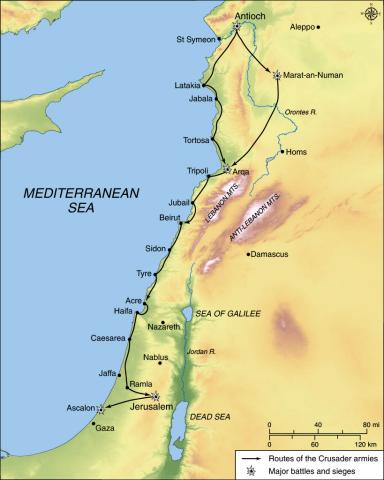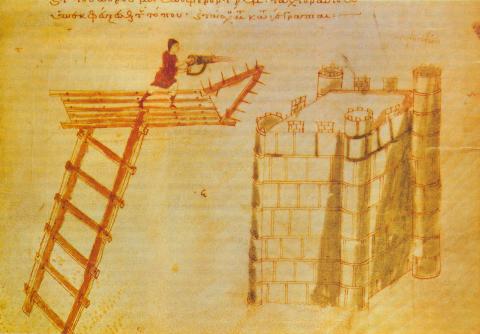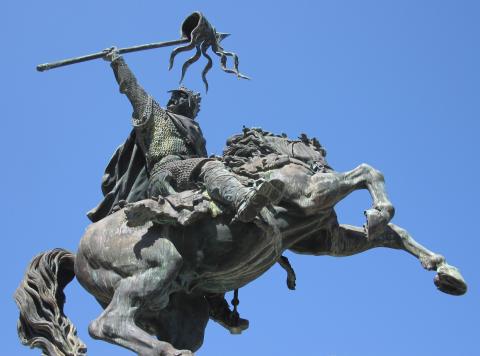The Road to Jerusalem
[10.33.2] Videntēs autem seniōrēs quia nihil agere poterant et frūstrā labōrābant, facit Raimundus comes dē Sānctō Egidīō fierī quoddam ligneum castrum forte et altum. Quod castrum ingeniātum et aedificātum erat super quātuor rotās; super quod stābant plūrēs mīlitēs, et Eurardus Vēnātor tubam fortiter sonāns. Subter vērō erant armātī mīlitēs, quī dēdūxērunt castrum usque prope urbis mūrum iuxtā turrim quamdam. Quod vidēns, gēns pāgāna statim fēcērunt īnstrūmentum quō iactābant maximōs lapidēs super castrum, ita ut paene nostrōs mīlitēs occīderent. Iaciēbant quoque Graecōs ignēs super castrum, putantēs illud ārdēre et dēvastārī. Sed Deus Omnipotēns nōluit ut castrum ārdēret hāc vice. Superēminēbat vērō omnēs mūrōs cīvitātis.
[10.33.3] Mīlitēs igitur nostrī quī erant in superiōrī sōlāriō, vidēlicet Willelmus dē Monte Pisleriō et aliī multī, iactābant immēnsōs lapidēs super illōs quī stābant in mūrō urbis, et ita percutiēbant eōs super clipeōs, ut clipeus et inimīcus caderent deorsum in cīvitātem in mortem. Ita faciēbant istī, aliī vērō tenēbant in hastīs honōrābilia signa, et cum lanceīs et hāmīs ferreīs putābant eōs trahere ad sē. Et sīc proeliātī sunt usque ad vesperam. Retrō castrum stābant presbyterī, clēricī, sacrīs vestibus indūtī, ōrantēs et obsecrantēs Deum ut suum dēfenderet populum, et Chrīstiānitātem exaltāret, ac pāgānismum dēpōneret.
notes
(November–December 1098) The crusaders build a mobile siege tower which they push toward a tower on the city walls. The Turks construct an engine for throwing rocks and "Greek fire" at the tower, but cannot destroy it. The crusaders on the top floor of their tower throw rocks at the enemy, and try to pull them off the walls with spears.
10.33.2
ligneum castrum: “a wooden siege tower.”
Eurardus Vēnātor: Evrard the Hunter, not otherwise known. He may have been a knight famous for using a hunting horn.
Graecōs ignēs: “Greek fire” was a flammable liquid used by the Byzantines in warfare (see media). Its exact composition is unknown to us.
Superēminēbat: the subject is the ligneum castrum.
10.33.3
in superiōrī sōlāriō: "on the top floor."
Willelmus dē Monte Pisleriō: William of Montpellier.
tenēbant in hastīs honōrābilia signa: “held distinguishing symbols (pennants) on their spears”; it is actually the spears, not the pennants, that are important here. Hill says she does not understand the significance of these spears, but perhaps spears with pennants were simply longer (see media).
vocabulary
10.33.2
frūstrā: in vain
ligneus –a –um: wooden
castrum –ī, n.: a castle, fortress
ingeniātus –a –um: naturally constituted, disposed, apt
rota –ae, f.: wheel
tuba –ae, f.: trumpet, war-trumpet
subter: below, underneath (adverb)
lapis –idis, f.: a stone
10.33.3
superemineō supereminēre supereminuī: to overtop, surmount, rise over
sōlārium –ī, n.: sun-porch
clipeus –ī, m.: a shield of metal
deorsum: downwards
hast –ae, f.: spear
lancea –ae, f.: a light spear or lance
hāmus –ī, m.: a hook
ferreus –a –um: iron
presbyter –ī, m.: priest
induō (3): to put on, assume
obsecrō (1): to beseech, supplicate





